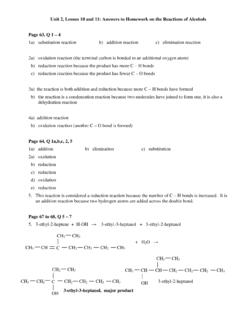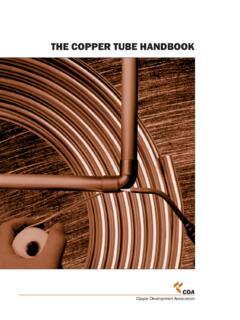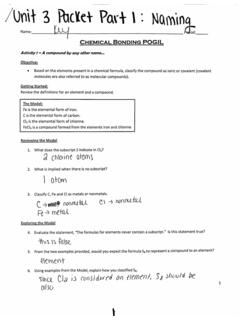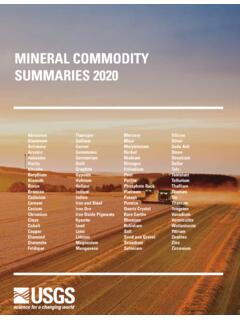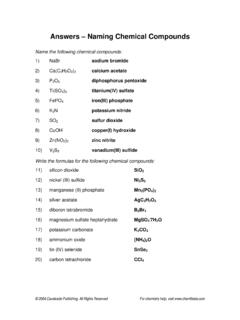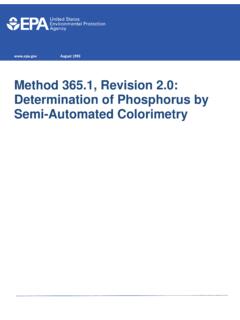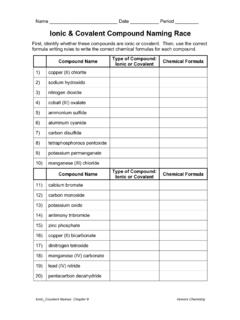Transcription of Nomenclature #1: Binary Ionic Compounds - Patterson Science
1 Nomenclature #1: Binary Ionic Compounds 1. Write the chemical formulas for the following Binary Ionic Compounds : barium oxide BaO lithium sulfide Li2S magnesium bromide MgBr2 strontium iodide SrI2 calcium sulfide CaS hydrogen bromide HBr lithium oxide Li2O potassium chloride KC cadmium fluoride CdF2 silver sulfide Ag2S potassium phosphide K3P zinc carbide Zn2C manganese (IV) sulfide MnS2 cobalt (II) bromide CoBr2 manganese (II) carbide Mn2C phosphorus (V) nitride P3N5 gold (I) iodide AuI nickel (III) phosphide NiP iron (II) bromide FeBr2 copper (II) sulfide CuS aluminum sulfide A 2S3 silicon iodide SiI4 lead (IV) carbide PbC aluminum fluoride A F3 arsenic (V) nitride As3N5 mercury (I) phosphide Hg3P cobalt (III) phosphide CoP cesium nitride Cs3N magnesium oxide MgO phosphorus (III) chloride PC 3 2. Name the following Binary Compounds . Use the Stock system where necessary: Li4C lithium carbide Ba3N2 barium nitride MgBr2 magnesium bromide A 2O3 aluminum oxide CaC 2 calcium chloride NaF sodium fluoride BaO barium oxide ZnBr2 zinc bromide Ag3N silver nitride KI potassium iodide SrS strontium sulfide Cd3P2 cadmium phosphide BiH5 bismuth (V) hydride AgC silver chloride AuBr3 gold (III) bromide CoO cobalt (II) oxide Mn3N4 manganese (IV) nitride MnS2 manganese (IV) sulfide FeF2 iron (II) fluoride Pb2C lead (II) carbide NiC 2 nickel (II) chloride Sr3P2 strontium phosphide HgO mercury (II) oxide CuF copper (I) fluoride CoBr3 cobalt (III) bromide NiBr3 nickel (III) bromide CrS chromium (II) sulfide FeN iron (III) nitride NiN nickel (III) nitride SiO2 silicon oxide SnO2 tin (IV) oxide Sb2S5 antimony (V) sulfide Au3P gold (I) phosphide AsH3 arsenic (III) hydride Nomenclature #2: Polyatomic Ionic Compounds 1.
2 Name the following Compounds (include Roman Numerals when necessary): Na2SO4 sodium sulfate A PO4 aluminum phosphate A (C O4)3 aluminum perchlorate AsPO3 arsenic (III) phosphite Ni(OH)3 nickel (III) hydroxide AgBrO3 silver bromate Pb(IO3)2 lead (II) iodate K3P potassium phosphide HgCN mercury (I) cyanide Mg(IO4)2 magnesium periodate Cd(BrO)2 cadmium hypobromite Au2S2O3 gold (I) thiosulfate KSCN potassium thiocyanate Bi(IO2)3 bismuth (III) iodite Co(BrO4)3 cobalt (III) perbromate Si(NO3)4 silicon nitrate CuCH3 COO copper (I) acetate NH4C O3 ammonium chlorate P(BrO2)3 phosphorus (III) bromite NiBO3 nickel (III) borate Fe(MnO4)2 iron (II) permanganate SnCrO4 tin (II) chromate Cr2(Cr2O7)3 chromium (III) dichromate Ba(C O)2 barium hypochlorite Pb(C O2)4 lead (IV) chlorite Pb(SO3)2 lead (IV) sulfite 2. Write the chemical formula for the following Ionic Compounds : zinc carbonate ZnCO3 aluminum hypochlorite A (C O)3 calcium phosphate Ca3(PO4)2 cadmium phosphate Cd3(PO4)2 iron (III) sulfate Fe2(SO4)3 mercury (II) chlorite Hg(C O2)2 potassium phosphite K3PO3 magnesium hydroxide Mg(OH)2 iron (II) chlorate Fe(C O3)2 cobalt (II) carbonate CoCO3 tin (IV) nitrite Sn(NO2)4 lithium thiocyanate LiSCN lead (IV) dichromate Pb(Cr2O7)2 silver sulfite Ag2SO3 ammonium sulfite (NH4)2SO3 arsenic (III) perbromate As(BrO4)3 nickel (III) acetate Ni(CH3 COO)3 nickel (II) chromate NiCrO4 antimony (V) cyanide Sb(CN)5 iron (II) carbide Fe2C mercury (I) permanganate HgMnO4 gold (III) hypoiodite Au(IO)3 zinc chloride ZnC 2 copper (II) oxalate CuC2O4 manganese (II) thiosulfate MnS2O3 chromium (III) phosphide CrP Nomenclature #3: Practice Naming Binary and Oxy-acids The Rules.
3 If the name of the ion ends in ide , name the acid: hydro_____ic acid if the name of the ion ends in ate , change the ate suffix to: ic acid if the name of the ion ends in ite , change the ite suffix to: ous acid Name of Ion Formula of Ion Formula of Acid Suffix on the Name of the Ion Name of Acid acetate CH3 COO1 HCH3 COO ate acetic acid borate BO33 H3BO3 ate boric acid bromate BrO31 HBrO3 ate bromic acid bromide Br1 HBr ide hydrobromic acid bromite BrO21 HBrO2 ite bromous acid carbonate CO32 H2CO3 ate carbonic acid chlorate C O31 HC O3 ate chloric acid chloride C 1 HC ide hydrochloric acid chlorite C O21 HC O2 ite chlorous acid chromate CrO42 H2 CrO4 ate chromic acid cyanide CN1 HCN ide hydrocyanic acid dichromate Cr2O72 H2Cr2O7 ate dichromic acid fluoride F1 HF ide hydrofluoric acid hypobromite BrO1 HBrO ite hypobromous acid hypochlorite C O1 HC O ite hypochlorous acid hypoiodite IO1 HIO ite hypoiodous acid iodide I1 HI ide hydroiodic acid iodate IO31 HIO3 ate iodic acid oxalate C2O42 H2C2O4 ate oxalic acid perbromate BrO41 HBrO4 ate perbromic acid perchlorate C O41
4 HC O4 ate perchloric acid periodate IO41 HIO4 ate periodic acid permanganate MnO41 HMnO4 ate permanganic acid phosphate PO43 H3PO4 ate phosphoric acid phosphide P3 H3P ide hydrophosphoric acid phosphite PO33 H3PO3 ite phosphorous acid sulfate SO43 H2SO4 ate sulfuric acid sulfide S2 H2S ide hydrosulfuric acid sulfite SO32 H2SO3 ite sulfurous acid thiocyanate SCN1 HSCN ate thiocyanic acid thiosulfate S2O32 H2S2O3 ate thiosulfuric acid Nomenclature #3: Naming Acids 1. Name the following Binary acids. These acids contain only hydrogen and one other element. Their names are always hydro_____ic acid . ( Hydro tells you it is a Binary acid) HI hydroiodic acid HF hydrofluoric acid H3P hydrophosphoric acid HBr hydrobromic acid HC hydrochloric acid H2S hydrosulfuric acid 2. Name these oxyacids. If the acid contains the ate ion, then it becomes the ic acid. The ite ion, becomes the ous acid.
5 Do not use hydro in these names. Hydro is only for Binary acids. HNO3 nitric acid HIO hypoiodous acid H3PO4 phosphoric acid H2CO3 carbonic acid HC O2 chlorous acid HCH3 COO acetic acid HBrO4 perbromic acid H2SO3 sulfurous acid HNO2 nitrous acid H3PO3 phosphorous acid (check your spelling) 3. Write the chemical formulas for these acids. Remember, hydro means it is a Binary acid (no oxygen) nitric acid HNO3 hydrobromic acid HBr nitrous acid HNO2 hypobromous acid HBrO phosphoric acid H3PO4 bromous acid HBrO2 phosphorous acid H3PO3 bromic acid HBrO3 hydrophosphoric acid H3P perbromic acid HBrO4 sulfuric acid H2SO4 perchloric acid HC O4 sulfurous acid H2SO3 chloric acid HC O3 hydrosulfuric acid H2S chlorous acid HC O2 carbonic acid H2CO3 hypochlorous acid HC O hydroiodic acid HI hydrochloric acid HC hypoiodous acid HIO acetic acid HCH3 COO iodous acid HIO2 hydrofluoric acid HF iodic acid HIO3 oxalic acid H2C2O4 periodic acid HIO4 chromic acid H2 CrO4 4.
6 Name the following acids. You may have to use the naming rules to figure some of them out. HBr hydrobromic acid H3BO3 boric acid H2SO3 sulfurous acid HIO hypoiodous acid HNO3 nitric acid H2CO3 carbonic acid H2S hydrosulfuric acid HC O4 perchloric acid H2Cr2O7 dichromic acid HF hydrofluoric acid H2SO4 sulfuric acid HCH3 COO acetic acid HC hydrochloric acid H3BO2 borous acid Nomenclature #4: Acids and Review 1. Name the following Compounds . If they begin with hydrogen, name them as acids. Sb(NO2)3 antimony (III) nitrite HIO hypoiodous acid (NH4)2CO3 ammonium carbonate LiC O4 lithium perchlorate HC O2 chlorous acid HCH3 COO acetic acid Au3PO3 gold (I) phosphite Cu3BO3 copper (I) borate HNO2 nitrous acid H3PO3 phosphorous acid MnO2 manganese (IV) oxide Fe(OH)3 iron (III) hydroxide H2SO3 sulfurous acid Hg2C2O4 mercury (I) oxalate HIO2 iodous acid H2CO3 carbonic acid H2S hydrosulfuric acid HC O4 perchloric acid H3PO4 phosphoric acid HCN hydrocyanic acid H3P hydrophosphoric acid Co2(Cr2O7)3 cobalt (III) dichromate HC hydrochloric acid HBrO2 bromous acid Mg3N2 magnesium nitride Sn(S2O3)2 tin (IV) thiosulfate HIO4 periodic acid P(SCN)3 phosphorus (III) thiocyanate H3BO3 boric acid HF hydrofluoric acid 2.
7 Write the chemical formulas for the following Compounds . Remember, hydro means a Binary acid. nitric acid HNO3 hydrochloric acid HC gold (III) thiocynate Au(SCN)3 chromic acid H2 CrO4 bromic acid HBrO3 potassium dichromate K2Cr2O7 phosphorous acid H3PO3 cadmium borate Cd3(BO3)2 ammonium hydroxide NH4OH perbromic acid HBrO4 chromium (III) chlorate Cr(C O3)3 bismuth (V) phosphide Bi3P5 nickel (II) iodite Ni(IO2)2 hydrobromic acid HBr hydrosulfuric acid H2S chlorous acid HC O2 carbonic acid H2CO3 calcium hydroxide Ca(OH)2 iron (II) fluoride FeF2 lead (IV) cyanide Pb(CN)4 hypoiodous acid HIO acetic acid HCH3 COO arsenic (V) acetate As(CH3 COO)5 zinc carbonate ZnCO3 lead (II) oxalate PbC2O4 oxalic acid H2C2O4 periodic acid HIO4 antimony (III) thiosulfate Sb2(S2O3)3 cesium carbide Cs4C ammonium perbromate NH4 BrO4 Nomenclature #5: Odds And Ends when Naming Ionic Compounds 1. Write correct formulae for each of the following names.
8 Sodium hypochlorite (bleach) NaC O mercury (II) periodate Hg(IO4)2 manganese (IV) oxide MnO2 tin (IV) bromate Sn(BrO3)4 potassium peroxide K2O2 zinc peroxide ZnO2 chromium (II) sulfate CrSO4 chromium (III) hydrogen sulfate Cr(HSO4)3 iron (III) acetate Fe(CH3 COO)3 silver peroxide Ag2O2 tin (IV) iodite Sn(IO2)4 lead (IV) hydrogen chromate Pb(HCrO4)4 lithium peroxide Li2O2 cobalt (II) perchlorate Co(C O4)2 arsenic (V) thiosulfate As2(S2O3)5 gold (III) fluoride AuF3 calcium permanganate Ca(MnO4)2 sodium peroxide Na2O2 aluminum thiocyanate A (SCN)3 strontium cyanate Sr(OCN)2 copper (II) hydrogen carbonate Cu(HCO3)2 lead (IV) hypoiodite Pb(IO)4 silver dichromate Ag2Cr2O7 iron (III) borate FeBO3 ammonium cyanide NH4CN antimony (III) hydrogen sulfite Sb(HSO3)3 mercury (II) acetate dihydrate Hg(CH3 COO)2 2 H2O silver hydrogen chromate tetrahydrate AgHCrO4 4 H2O copper (II) sulfate pentahydrate CuSO4 5 H2O copper (I) carbonate heptahydrate Cu2CO3 7 H2O iron (III) dihydrogen phosphite nonahydrate Fe(H2PO3)3 9 H2O 2.
9 For each of the following write correct names. Na2O2 sodium peroxide Hg(C O4)2 mercury (II) perchlorate KNO2 potassium nitrite Zn(OH)2 zinc hydroxide CrSO4 chromium (II) sulfate Cr(HSO3)3 chromium (III) hydrogen sulfite Fe(CH3 COO)3 iron (III) acetate Li2O2 lithium peroxide AuF3 gold (III) fluoride Ca(HCrO4)2 calcium hydrogen chromate HgMnO4 mercury (I) permanganate NaOCN sodium cyanate Pb(IO)2 lead (II) hypoiodite Sn(H2PO4)2 tin (II) dihydrogen phosphate CuHSO4 copper (I) hydrogen sulfate A 2(Cr2O7)3 aluminum dichromate Ag2 HPO3 silver hydrogen phosphite H2O2 hydrogen peroxide NiPO4 nickel (III) phosphate Pb(HCO3)4 lead (IV) hydrogen carbonate Co(IO2)2 cobalt (II) iodite Sb3(BO3)5 antimony (V) borate MnO2 4 H2O manganese (IV) oxide tetrahydrate CuNO3 6 H2O copper (I) nitrate hexahydrate NaCH3 COO 3 H2O sodium acetate trihydrate AuCN 8 H2O gold (I) cyanide octahydrate Nomenclature #6.
10 Binary Covalent Compounds Ionic Compounds are formed when _____ atoms bond with _____ atoms. They are named using the rules for naming Ionic Compounds that we have been learning up until now. Covalent (molecular) Compounds are formed when two or more _____ atoms are bonded together. There is separate IUPAC system of naming that is used for Binary covalent Compounds , called the prefix system. It uses the same prefixes that we used to name hydrated Compounds . In the prefix system, the number of atoms of each element in the compound is indicated with a prefix. Because these rules are for Binary Compounds , the ending of the second element is changed to ide . There are two additional rules: 1. If there is only one atom of the first element, then a prefix is not used for that element: eg. CO2 is _____ eg. NI3 is _____ 2. When the second element is oxygen and the prefix ends in an o or a , then the o or a is omitted: eg.
